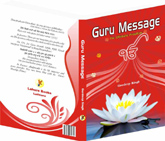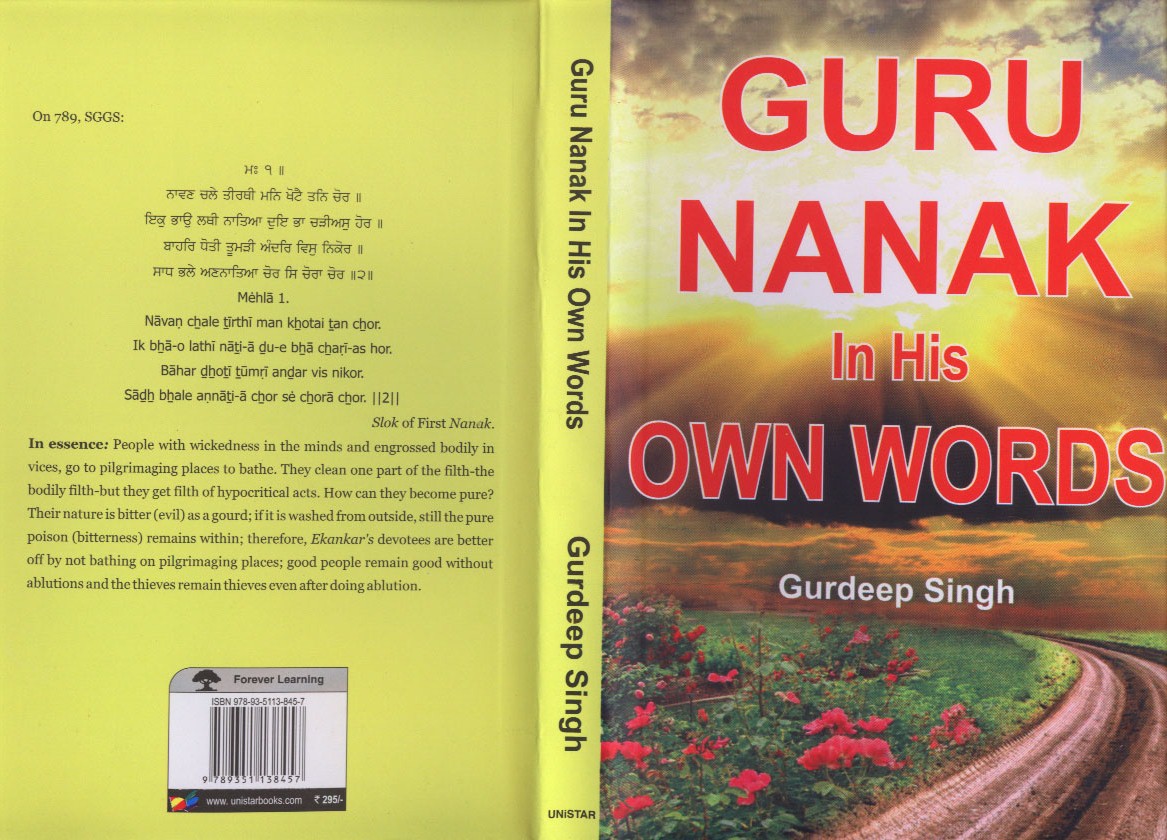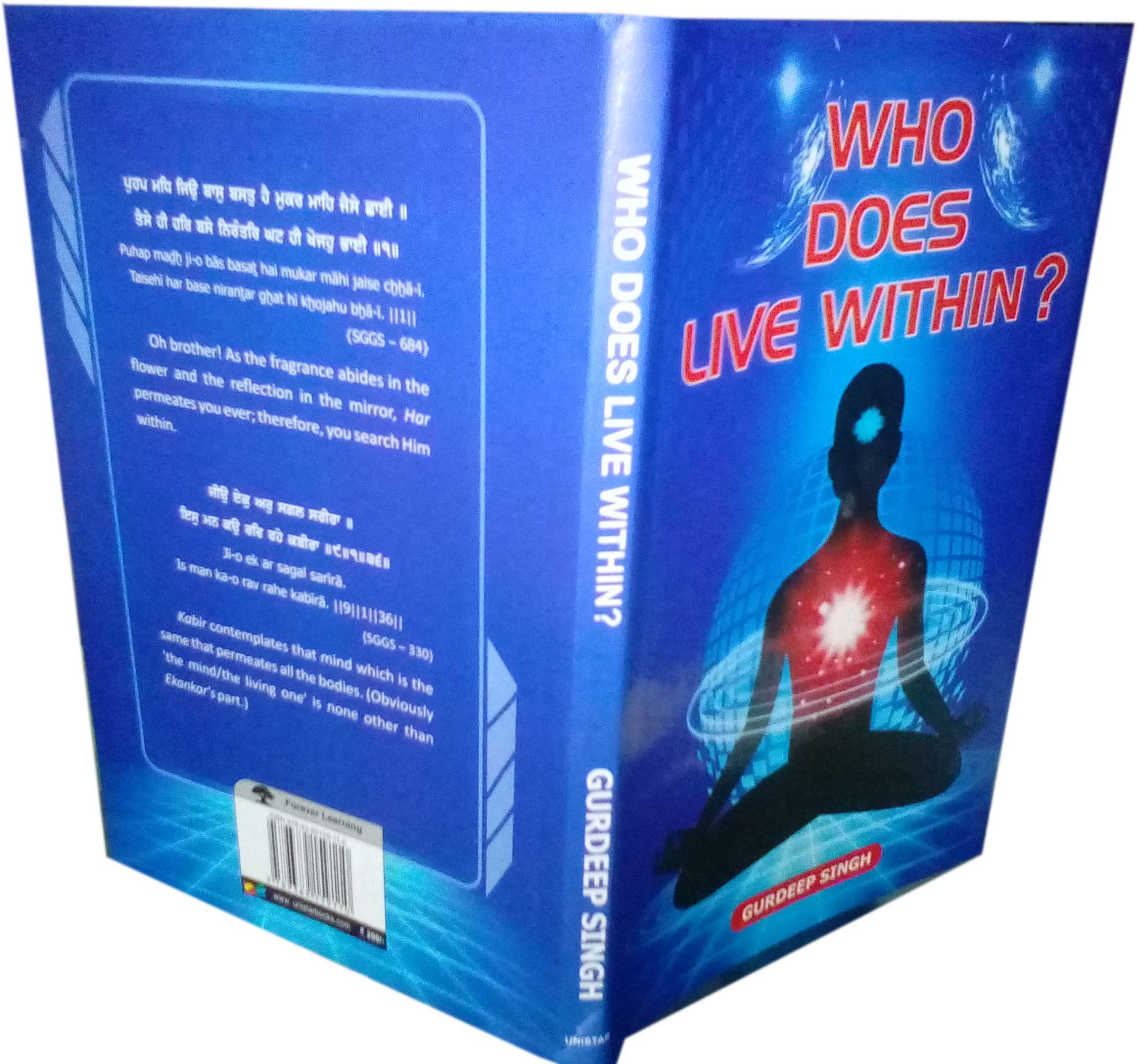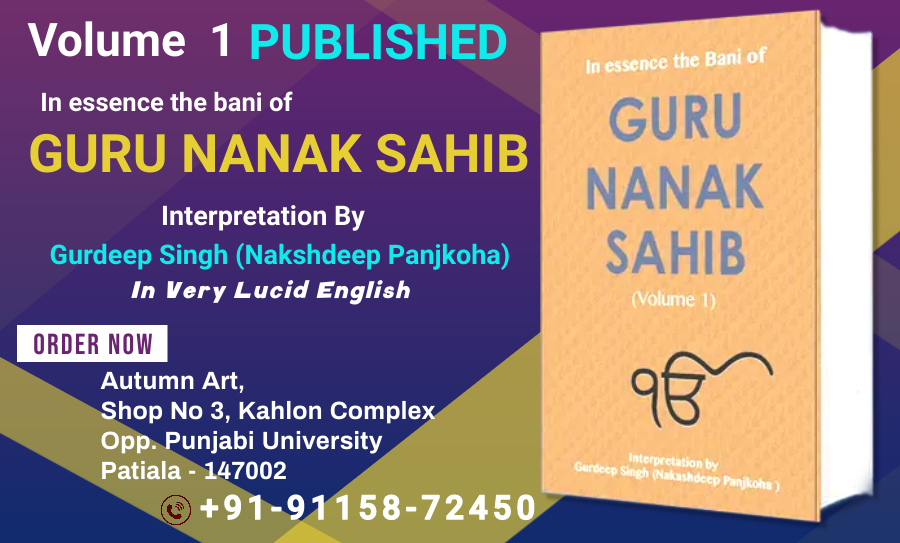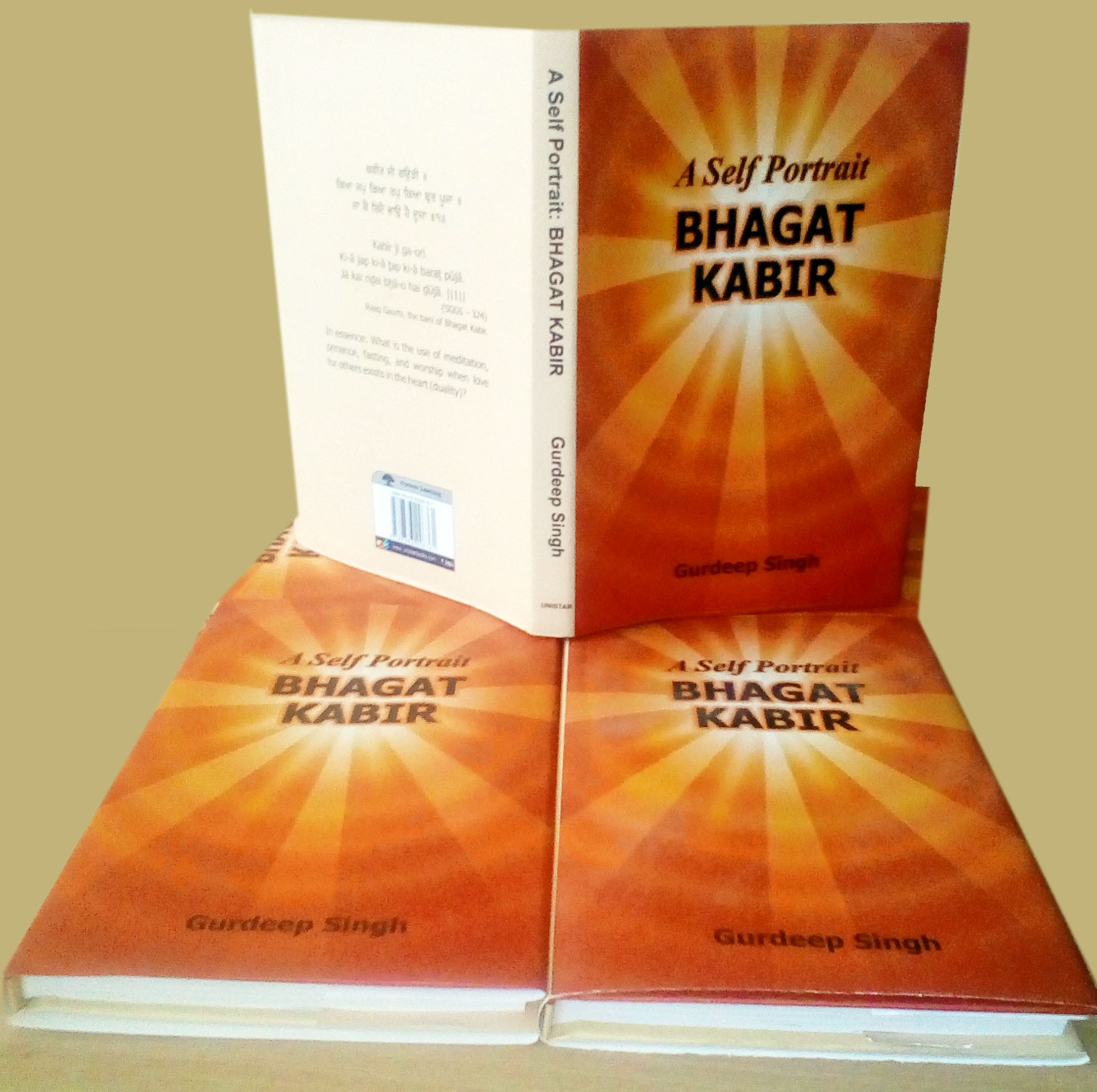Let us know how does our Creator exist in all the lives according to the Gurbani. On 1169, SGGS, First Nanak writes:
ਬਸੰਤੁ ਮਹਲਾ ੧ ॥
ਸਗਲ ਭਵਨ ਤੇਰੀ ਮਾਇਆ ਮੋਹ ॥ ਮੈ ਅਵਰੁ ਨ ਦੀਸੈ ਸਰਬ ਤੋਹ ॥
Basanṯ mėhlā 1.
Sagal bẖavan ṯerī mā-i-ā moh. Mai avar na ḏīsai sarab ṯoh.
Raag Basant, bani of First Nanak.
In essence: Oh Akalpurakh! All the worlds are expansion of your Maya and its attachment. I don’t see other than you; you are in all.
Obviously, the Guru sees only the Creator in His creation; in other words, if we get of our duality, we also will see Him in His entire creation as he does. Look at these verses on 1273, SGGS;
ਸਭ ਮਹਿ ਜੀਉ ਜੀਉ ਹੈ ਸੋਈ ਘਟਿ ਘਟਿ ਰਹਿਆ ਸਮਾਈ ॥
ਗੁਰ ਪਰਸਾਦਿ ਘਰ ਹੀ ਪਰਗਾਸਿਆ ਸਹਜੇ ਸਹਜਿ ਸਮਾਈ ॥੭॥
Sabẖ mėh jī-o jī-o hai so-ī gẖat gẖat rahi-ā samā-ī.
Gur parsāḏ gẖar hī pargāsi-ā sėhje sahj samā-ī. ||7||
In the all lives breathes only Akalpuakh, who permeates everyone’s heart. With the Guru’s blessings, Akalpurakh becomes manifest within and one intuitively gets absorbed in Him.
Again the issue is to see the Creator after getting rid of the duality we are enveloped in. Every form we see is different; it is very much clear before our eyes that every human being has his or own identity, but the Guru says there is none other than Him; therefore, it is fair to say that even with different identities, all are part of Him. The Guru, without an iota of the duality, sees Him in all forms, colors and various attributes, but we don’t. About this problem, the Guru speaks on 1142, SGGS:
ਮ; ੧ ॥
ਜਾਂ ਹਉ ਤੇਰਾ ਤਾਂ ਸਭੁ ਕਿਛੁ ਮੇਰਾ ਹਉ ਨਾਹੀ ਤੂ ਹੋਵਹਿ ॥
ਆਪੇ ਸਕਤਾ ਆਪੇ ਸੁਰਤਾ ਸਕਤੀ ਜਗਤੁ ਪਰੋਵਹਿ ॥
ਆਪੇ ਭੇਜੇ ਆਪੇ ਸਦੇ ਰਚਨਾ ਰਚਿ ਰਚਿ ਵੇਖੈ ॥
ਨਾਨਕ ਸਚਾ ਸਚੀ ਨਾਂਈ ਸਚੁ ਪਵੈ ਧੁਰਿ ਲੇਖੈ ॥੨॥
Mėhlā 1.
Jāʼn ha-o ṯerā ṯāʼn sabẖ kicẖẖ merā ha-o nāhī ṯū hovėh.
Āpe sakṯā āpe surṯā sakṯī jagaṯ parovėh.
Āpe bẖeje āpe saḏe racẖnā racẖ racẖ vekẖai.
Nānak sacẖā sacẖī nāʼn-ī sacẖ pavai ḏẖur lekẖai. ||2||
First Nanak.
In essence: Oh Akalpurakh! When I become yours, everything appears to be mine; when the self-conceit is not there, you are seen. Akalpurakh is all-powerful and He Himself is the meditator; He has strung the entire world in His power. He sends and calls back the beings; He Himself fashions creation; He takes care of it. Oh Nanak! Akalpurakh is eternal, so is His praise; it is only His praise that is acceptable to Him.
Above, the first verse ਜਾਂ ਹਉ ਤੇਰਾ ਤਾਂ ਸਭੁ ਕਿਛੁ ਮੇਰਾ ਹਉ ਨਾਹੀ ਤੂ ਹੋਵਹਿ ॥ states that we need to become His to know Him; according to the Guru, becoming His means becoming a Gurmukh ( One who eliminates one’s duality and self-conceit). Once we become His, we see nothing separate from Him, and when our “Self/self-conceit” goes away, we see Him within. As we get rid of the duality, we enter into a new world in which what we now see as very important becomes meaningless, but spiritually we get elevated so high that we can see Him present in every living or lifeless objects. The Guru stresses on eliminating the duality on 237/238, SGGS
ਐਸਾ ਕੋਇ ਜਿ ਦੁਬਿਧਾ ਮਾਰਿ ਗਵਾਵੈ ॥
ਇਸਹਿ ਮਾਰਿ ਰਾਜ ਜੋਗੁ ਕਮਾਵੈ ॥੧॥ ਰਹਾਉ ॥
Aisā ko-e jė ḏubiḏẖā mār gavāvai.
Isėh mār rāj jog kamāvai. ||1|| rahā-o.
In essence: There is a rare one who eliminates one’s duality; if one does so, one enjoys union with Akalpurakh while living in one’s family. Pause.
ਜੋ ਇਸੁ ਮਾਰੇ ਤਿਸ ਕਉ ਭਉ ਨਾਹਿ ॥ ਜੋ ਇਸੁ ਮਾਰੇ ਸੁ ਨਾਮਿ ਸਮਾਹਿ ॥
ਜੋ ਇਸੁ ਮਾਰੇ ਤਿਸ ਕੀ ਤ੍ਰਿਸਨਾ ਬੁਝੈ ॥ ਜੋ ਇਸੁ ਮਾਰੇ ਸੁ ਦਰਗਹ ਸਿਝੈ ॥੨॥
Jo is māre ṯis ka-o bẖa-o nāhi. Jo is māre so nām samāhi.
Jo is māre ṯis kī ṯarisnā bujẖai. Jo is māre so ḏargėh sijẖai. ||2||
One, who overcomes one’s duality, has no fear of any one, because one remains absorbed in Har’s name. One who eradicates it (duality) gets one’s desires satisfied and obtains glory in Har’s court.
ਜੋ ਇਸੁ ਮਾਰੇ ਸੋ ਧਨਵੰਤਾ ॥ ਜੋ ਇਸੁ ਮਾਰੇ ਸੋ ਪਤਿਵੰਤਾ ॥
ਜੋ ਇਸੁ ਮਾਰੇ ਸੋਈ ਜਤੀ ॥ ਜੋ ਇਸੁ ਮਾਰੇ ਤਿਸੁ ਹੋਵੈ ਗਤੀ ॥੩॥
Jo is māre so ḏẖanvanṯā. Jo is māre so paṯivanṯā.
Jo is māre so-ī jaṯī. Jo is māre ṯis hovai gaṯī. ||3||
A person, who eradicates it, is a wealthy and honorable. One who eradicates it is rendered celibate, and thus one becomes liberated.
ਇਸੁ ਮਾਰੀ ਬਿਨੁ ਗਿਆਨੁ ਨ ਹੋਈ ॥ ਇਸੁ ਮਾਰੀ ਬਿਨੁ ਜੂਠਿ ਨ ਧੋਈ ॥
ਇਸੁ ਮਾਰੀ ਬਿਨੁ ਸਭੁ ਕਿਛੁ ਮੈਲਾ ॥ ਇਸੁ ਮਾਰੀ ਬਿਨੁ ਸਭੁ ਕਿਛੁ ਜਉਲਾ ॥੭॥
Is mārī bin gi-ān na ho-ī. Is mārī bin jūṯẖ na ḏẖo-ī.
Is mārī bin sabẖ kicẖẖ mailā. Is mārī bin sabẖ kicẖẖ ja-ulā. ||7||
Without getting rid of the duality, Prabh’s knowledge is not obtained and the filth (of Maya) is not washed off. Without getting rid of it, everything is defiled and one remains separated from one’s source, Prabh.
There is a path to achieve a duality free state of mind. On 1343, SGGS, see how the Gurbani guides us towards this pursuit of knowing Him
ਏਹੁ ਸਰੀਰੁ ਹੈ ਤ੍ਰੈ ਗੁਣ ਧਾਤੁ ॥ ਇਸ ਨੋ ਵਿਆਪੈ ਸੋਗ ਸੰਤਾਪੁ ॥
Ėhu sarīr hai ṯarai guṇḏẖāṯ. Is no vi-āpai sog sanṯāp.
This body is into the three qualities of Maya, because of that, it endures sorrows and miseries.
ਸੋ ਸੇਵਹੁ ਜਿਸੁ ਮਾਈ ਨ ਬਾਪੁ ॥ ਵਿਚਹੁ ਚੂਕੈ ਤਿਸਨਾ ਅਰੁ ਆਪੁ ॥੫॥
So sevhu jis mā-ī na bāp. Vicẖahu cẖūkai ṯisnā ar āp. ||5||
Serve Ekankar, who has no mother or father; by doing so, your internal desires and self-conceit end.
Our bodies are fragile and prone to diseases; therefore, instead of getting lost for only physical pleasures, we should devote ourselves towards the Creator by getting rid of our desires and self-conceit. Then He is seen, but the Guru says we need a Satiguru who has seen Him and who can show Him us:
ਜਹ ਜਹ ਦੇਖਾ ਤਹ ਤਹ ਸੋਈ ॥ ਬਿਨੁ ਸਤਿਗੁਰ ਭੇਟੇ ਮੁਕਤਿ ਨ ਹੋਈ ॥
Jah jah ḏekẖāṯah ṯah so-ī. Bin saṯgur bẖete mukaṯ na ho-ī.
Wherever I look, I see only Ekankar. Without meeting a Satiguru, liberation is not obtained.
ਹਿਰਦੈ ਸਚੁ ਏਹ ਕਰਣੀ ਸਾਰੁ ॥ ਹੋਰੁ ਸਭੁ ਪਾਖੰਡੁ ਪੂਜ ਖੁਆਰੁ ॥੬॥
Hirḏai sacẖ eh karṇī sār. Hor sabẖ pakẖand pūj kẖu-ār. ||6||
Keeping Akalpurakh within is a sublime deed; other all deeds are acts of hypocrisy, and worshipping of that kind leads to frustration.
In the following slok on 143, SGGS, the Guru, through the examples of the worldly ways, advises the follower to get bound with Ekankar.
ਮ; ੧ ॥
ਕੈਹਾ ਕੰਚਨੁ ਤੁਟੈ ਸਾਰੁ ॥ ਅਗਨੀ ਗੰਢੁ ਪਾਏ ਲੋਹਾਰੁ ॥
ਗੋਰੀ ਸੇਤੀ ਤੁਟੈ ਭਤਾਰੁ ॥ ਪੁਤੀ ਗੰਢੁ ਪਵੈ ਸੰਸਾਰਿ ॥
ਰਾਜਾ ਮੰਗੈ ਦਿਤੈ ਗੰਢੁ ਪਾਇ ॥ ਭੁਖਿਆ ਗੰਢੁ ਪਵੈ ਜਾ ਖਾਇ ॥
ਕਾਲਾ ਗੰਢੁ ਨਦੀਆ ਮੀਹ ਝੋਲ ॥ ਗੰਢੁ ਪਰੀਤੀ ਮਿਠੇ ਬੋਲ ॥
ਬੇਦਾ ਗੰਢੁ ਬੋਲੇ ਸਚੁ ਕੋਇ ॥ ਮੁਇਆ ਗੰਢੁ ਨੇਕੀ ਸਤੁ ਹੋਇ ॥
ਏਤੁ ਗੰਢਿ ਵਰਤੈ ਸੰਸਾਰੁ ॥ ਮੂਰਖ ਗੰਢੁ ਪਵੈ ਮੁਹਿ ਮਾਰ ॥
ਨਾਨਕੁ ਆਖੈ ਏਹੁ ਬੀਚਾਰੁ ॥ ਸਿਫਤੀ ਗੰਢੁ ਪਵੈ ਦਰਬਾਰਿ ॥੨॥
Mėhlā 1.
Kaihā kancẖan ṯutai sār. Agnī gandẖ pā-e lohār.
Gorī seṯī ṯutai bẖaṯār. Puṯīʼn gandẖ pavai sansār.
Rājā mangai ḏiṯai gandẖ pā-e. Bẖukẖi-ā gandẖ pavai jā kẖā-e.
Kālā gandẖ naḏī-ā mīh jẖol. Gandẖ parīṯī miṯẖe bol.
Beḏā gandẖ bole sacẖ ko-e. Mu-i-ā gandẖ nekī saṯ ho-e.
Ėṯ gandẖ varṯai sansār. Mūrakẖ gandẖ pavai muhi mār.
Nānak ākẖai ehu bīcẖār. Sifṯī gandẖ pavai ḏarbār. ||2||
The bani of First Nanak.
In essence: When something of bronze, or gold or iron breaks, the smith welds it with fire. When husband and wife break away, through their son, their reconciliation is materialized because of their continuity of ancestry. When the king demands revenue, by giving it to him, a bond is established. Hungry person can keep relations if he gets something to eat. Relief from famine is obtained when the rivers run with heavy rain. Sweet words fortify the love. When one speaks the truth, one’s bond is built with religious scriptures. If one does good deeds, after death, the world shows bond with one through remembering one. Such kinds of alliances prevail in the world. Fools are mended with punishment. Nanak expresses this fact that the bond with the Creator is made through praising Him.
Once a bond is created with the Creator after getting rid of one’s duality and self-conceit through the Guru, one is left with Ekankar only. Then one embraces positivity through attaining virtues and opposing the negativity. One goes through happiness or bad times with a positive mood. And, the death that scares the world is looked as a process of change; in other words, it is taken as a call from Him. On 12, SGGS, look how death appears to the Creator’s true lover:
ਸੰਬਤਿ ਸਾਹਾ ਲਿਖਿਆ ਮਿਲਿ ਕਰਿ ਪਾਵਹੁ ਤੇਲੁ ॥
ਦੇਹੁ ਸਜਣ ਅਸੀਸੜੀਆ ਜਿਉ ਹੋਵੈ ਸਾਹਿਬ ਸਿਉ ਮੇਲੁ ॥੩॥
Sambaṯ sāhā likẖi-ā mil kar pāvhu ṯel.
Ḏeh sajaṇ asīsṛī-ā ji-o hovai sāhib si-o mel. ||3||
Oh friends! An auspicious time of Akalpurakh’s union has been fixed; pour the oil on the entrance of the house to celebrate this happy moment. Wish me good wishes so that I meet my Master.
ਘਰਿ ਘਰਿ ਏਹੋ ਪਾਹੁਚਾ ਸਦੜੇ ਨਿਤ ਪਵੰਨਿ ॥
ਸਦਣਹਾਰਾ ਸਿਮਰੀਐ ਨਾਨਕ ਸੇ ਦਿਹ ਆਵੰਨਿ ॥੪॥੧॥
Gẖar gẖar eho pāhucẖā saḏ-ṛe niṯ pavann.
Saḏaṇhārā simrī-ai Nānak se ḏih āvann. ||4||1||
This summon is sent to every house (everyone) and such calls come every day. Contemplate Akalpurakh, who summons everyone. Oh Nanak! Such days are coming.
As the Guru advises us not to take death as a scary moment, he describes it also in detail. First, he tells how life originates on 19, SGGS:
ਸਾਚੇ ਤੇ ਪਵਨਾ ਭਇਆ ਪਵਨੈ ਤੇ ਜਲੁ ਹੋਇ ॥
ਜਲ ਤੇ ਤ੍ਰਿਭਵਣੁ ਸਾਜਿਆ ਘਟਿ ਘਟਿ ਜੋਤਿ ਸਮੋਇ ॥
ਨਿਰਮਲੁ ਮੈਲਾ ਨਾ ਥੀਐ ਸਬਦਿ ਰਤੇ ਪਤਿ ਹੋਇ ॥੩॥
Sācẖe ṯe pavnā bẖa-i-ā pavnai ṯe jal ho-e.
Jal ṯe ṯaribẖavaṇ sāji-ā gẖat gẖat joṯ samo-e.
Nirmal mailā nā thī-ai sabaḏ raṯe paṯ ho-e. ||3||
From Akalpurakh, the air came into existence. From the air, the water became and from the water, the entire world came into existence. It is Akalpurakh’s light that is permeating every one. A person who gets imbued with Akalpurakh doesn’t become impure. Honor is obtained by getting drenched in His name. (also the Guru’s shabda that helps to get imbued with Akalpurakh).
About the death, he makes clear through his following verses on 152:
ਗਉੜੀ ਮਹਲਾ ੧ ॥
ਪਉਣੈ ਪਾਣੀ ਅਗਨੀ ਕਾ ਮੇਲੁ ॥ ਚੰਚਲ ਚਪਲ ਬੁਧਿ ਕਾ ਖੇਲੁ ॥
ਨਉ ਦਰਵਾਜੇ ਦਸਵਾ ਦੁਆਰੁ ॥ ਬੁਝੁ ਰੇ ਗਿਆਨੀ ਏਹੁ ਬੀਚਾਰੁ ॥੧॥
Ga-oṛī mėhlā 1.
Pa-uṇai pāṇī agnī kā mel. Cẖancẖal cẖapal buḏẖ kā kẖel.
Na-o ḏarvāje ḏasvā ḏu-ār. Bujẖ re gi-ānī ehu bīcẖār. ||1||
Raag Gaurhi, the bani of First Nanak.
In essence: The body is a union of air, water, and fire; the fickle mind plays in it with its intellect. In it are nine openings and a door known as “the tenth door.” Oh wise man! Reflect on this!
ਕਥਤਾ ਬਕਤਾ ਸੁਨਤਾ ਸੋਈ ॥
ਆਪੁ ਬੀਚਾਰੇ ਸੁ ਗਿਆਨੀ ਹੋਈ ॥੧॥ ਰਹਾਉ ॥
Kathṯā bakṯā sunṯā so-ī.
Āp bīcẖāre so gi-ānī ho-ī. ||1|| rahā-o.
It is Akalpurakh who speaks, teaches, and listens (with His presence within every life). The one who reflects on one’s “inner self” becomes wise (the Knower of the Creator). Pause.
In the Gurbani, it is stressed that Prabh/Naam is found within, but first one needs to understand one’s “inner self”. Usually one remains involved with one’s body. It is expressed that the “inner self” actually acts under the ordinance of the Creator because it is a part of the Creator’s light (Jyoti of jyot). When one understands completely how all this is put in work, one also realizes that it is only the Creator, who is staging a show through this world; otherwise, one remains into the duality. Reread the first two verses and then analyze what is said in the “Rahao verses.” By doing so, it becomes clear that it is impossible to comprehend without experiencing what the Guru says.
ਦੇਹੀ ਮਾਟੀ ਬੋਲੈ ਪਉਣੁ ॥ ਬੁਝੁ ਰੇ ਗਿਆਨੀ ਮੂਆ ਹੈ ਕਉਣੁ ॥
ਮੂਈ ਸੁਰਤਿ ਬਾਦੁ ਅਹੰਕਾਰੁ ॥ ਓਹੁ ਨ ਮੂਆ ਜੋ ਦੇਖਣਹਾਰੁ ॥੨॥
Ḏehī mātī bolai pa-uṇ. Bujẖ re gi-ānī mū-ā hai ka-uṇ.
Mū-ī suraṯ bāḏ ahaʼnkār. Oh na mū-ā jo ḏekẖaṇhār. ||2||
The body is dust, but it is the breath that is heard sounding. O Wise one! Who has died then (The dust-body becomes dust again and the breath merges with the wind; then who is dead)? The interest in strife, conceit, and Maya has died; however, one who sees all this doesn’t die (Means only the game of one’s interest in conceit, strife and Maya is ended at one’s death).
The Guru also names the witness, a part of the Creator, that exists in our bodies, and the witness doesn’t die as expressed above. Obviously at a death, the physical body, which also emanates from the Creator’s manifested /sargun form, dies. And, crying for the witness is discouraged in the Gurbani. That way, it also becomes clear that our different identities are our bodies, which are also parts of the Sargun Creator (who is self illumined). Read the following to understand “the witnessing part” of the Nirgun/beyond attributes on 1034, SGGS: the Guru is talking about here about the person who enshrines Ekankar’s name within:
ਨਿਰਮਲ ਕਾਇਆ ਊਜਲ ਹੰਸਾ ॥
ਤਿਸੁ ਵਿਚਿ ਨਾਮੁ ਨਿਰੰਜਨ ਅੰਸਾ ॥
ਸਗਲੇ ਦੂਖ ਅੰਮ੍ਰਿਤੁ ਕਰਿ ਪੀਵੈ ਬਾਹੁੜਿ ਦੂਖੁ ਨ ਪਾਇਦਾ ॥੬॥
Nirmal kā-i-ā ūjal hansā.
Ŧis vicẖ nām niranjan ansā.
Sagle ḏūkẖ amriṯ kar pīvai bāhuṛ ḏūkẖ na pā-iḏā. ||6||
In essence: Pure is that body in which dwells the pure soul, and in it abides Ekankar’s name, a part of the immaculate Creator. Such a pure person takes his or her all pains as nectar given by Ekankar’s and he or she doesn’t suffer again.
The Guru explains what happens when one is said to be dead. One’s body is made of dust and it mingles back into the dust; one’s breath merges back into the air; however, one who was witnessing all that doesn’t die. Some scholars interpret these verses metaphorically that when one’s interest in conceit, strife and Maya dies, one becomes one with Ekankar. When we read the last verses, it becomes apparent that the Guru also talks about the real death and defines it.
ਜੈ ਕਾਰਣਿ ਤਟਿ ਤੀਰਥ ਜਾਹੀ ॥ ਰਤਨ ਪਦਾਰਥ ਘਟ ਹੀ ਮਾਹੀ ॥
ਪੜਿ ਪੜਿ ਪੰਡਿਤੁ ਬਾਦੁ ਵਖਾਣੈ ॥ ਭੀਤਰਿ ਹੋਦੀ ਵਸਤੁ ਨ ਜਾਣੈ ॥੩॥
Jai kāraṇ ṯat ṯirath jāhī. Raṯan paḏārath gẖat hī māhī.
Paṛ paṛ pandiṯ bāḏ vakẖāṇai. Bẖīṯar hoḏī vasaṯ na jāṇai. ||3||
That invaluable Akalpurakh’s name (Him) jewel, for which the people go to pilgrimaging places, is within the body (Remember, it is His part). The Pundit just reads (the scripture) and gets into arguments, but he doesn’t know about that real thing that already exists within (Akalpurakh’s presence; to realize Him, there is no need to go to the pilgrimaging places).
ਹਉ ਨ ਮੂਆ ਮੇਰੀ ਮੁਈ ਬਲਾਇ ॥ ਓਹੁ ਨ ਮੂਆ ਜੋ ਰਹਿਆ ਸਮਾਇ ॥
ਕਹੁ ਨਾਨਕ ਗੁਰਿ ਬ੍ਰਹਮੁ ਦਿਖਾਇਆ ॥ ਮਰਤਾ ਜਾਤਾ ਨਦਰਿ ਨ ਆਇਆ ॥੪॥੪॥
Ha-o na mū-ā merī mu-ī balā-e. Oh na mū-ā jo rahi-ā samā-e.
Kaho Nānak gur barahm ḏikẖā-i-ā. Marṯā jāṯā naḏar na ā-i-ā. ||4||4||
Nanak says this: The Guru has shown me Akalpurakh, and I don’t see anyone dying or going. (Now) I understand that it is the calamitous conceit that has died not I, the soul (the witness/the part). Akalpurakh (that part of the soul that exists in all), who pervades all, doesn’t die either.
On 188, SGGS, Fifth Nanak questions those who cry over death and explains that the death we witness is of a body only not of the one that breathes in it:
ਏਕਾ ਮਾਟੀ ਏਕਾ ਜੋਤਿ ॥
ਏਕੋ ਪਵਨੁ ਕਹਾ ਕਉਨੁ ਰੋਤਿ ॥੨॥
Ėkā mātī ekā joṯ.
Ėko pavan kahā ka-un roṯ. ||2||
All are made of the same dust. The same light of Akalpurakh exists in all and the same breath passes through all. (When the breath stops) Why and for whom one should cry?
In the above verses, in a very compact manner, Fifth Nanak sums up the idea given by First Nanak on 599 SGGS, in raag Sorath, ਤਤੁ ਨਿਰੰਜਨੁ ਜੋਤਿ ਸਬਾਈ ਸੋਹੰ ਭੇਦੁ ਨ ਕੋਈ ਜੀਉ ॥Ŧaṯ niranjan joṯ sabā-ī sohaʼn bẖeḏ na ko-ī jī-o. In essence: the immaculate Creator is the origin of all the lives and His light exists in all; therefore, there is no difference between Him and His creation”. He says that we emanate from the same source and there is no real difference. Just because of our nature drenched in the duality, we always see all others different than one and another instead of accepting them as a part of the Creator (we worship.). Also saying that killing the non-believer is right is actually going against the Creator. The Guru says that such people, regardless what they establish here, are zero in Akalpurakh’s view.
Now see how clearly the death of a living being is not accepted:
ਮੇਰਾ ਮੇਰਾ ਕਰਿ ਬਿਲਲਾਹੀ ॥
ਮਰਣਹਾਰੁ ਇਹੁ ਜੀਅਰਾ ਨਾਹੀ ॥੩॥
Merā merā kar billāhī.
Maraṇhār ih jī-arā nāhī. ||3||
(When one dies, other people bewail by calling “my this relative or that relative has died”) The mortals bewail by calling the dead “mine” but they do not understand that the living being doesn’t die.
ਕਹੁ ਨਾਨਕ ਗੁਰਿ ਖੋਲੇ ਕਪਾਟ ॥
ਮੁਕਤੁ ਭਏ ਬਿਨਸੇ ਭ੍ਰਮ ਥਾਟ ॥੪॥੪੩॥੧੧੨॥
Kaho Nānak gur kẖole kapāt.
Mukaṯ bẖa-e binse bẖaram thāt. ||4||43||112||
Oh Nanak! Say this: Those persons, whose closed shutters of their minds are opened by the Guru, get liberated and their doubts and faith in expansions go away.
As we, in the duality, fail to realize the oneness of the Creator, the enlightened ones keep telling us that there is none out there but the Creator, who doesn’t die in parts or in His entirety. We have different identities just because of the forms we enveloped in; otherwise, we are all the same: His parts. Our identities and our belief in them keep us apart and make us believe that we are different though actually we are not. To become His again becomes clear here, because it is the part that mingles with the source. As expressed earlier, He is seen through every life and thing; nonetheless, the Guru tells us that explaining the Creator fully is almost impossible:
Page 1239-1240
ਮਹਲਾ ੧ ॥
ਆਖਣਿ ਅਉਖਾ ਸੁਨਣਿ ਅਉਖਾ ਆਖਿ ਨ ਜਾਪੀ ਆਖਿ ॥
ਇਕਿ ਆਖਿ ਆਖਹਿ ਸਬਦੁ ਭਾਖਹਿ ਅਰਧ ਉਰਧ ਦਿਨੁ ਰਾਤਿ ॥
Mėhlā 1.
Ākẖaṇ a-ukẖā sunaṇ a-ukẖā ākẖ na jāpī ākẖ.
Ik ākẖ ākẖahi sabaḏ bẖākẖahi araḏẖ uraḏẖ ḏin rāṯ.
First Nanak.
In essence: It is very hard to express Prabh in any way, and even after expressing Him, it is not possible to understand Him though there are some who try to express and tell about Him;
ਜੇ ਕਿਹੁ ਹੋਇ ਤ ਕਿਹੁ ਦਿਸੈ ਜਾਪੈ ਰੂਪੁ ਨ ਜਾਤਿ ॥
ਸਭਿ ਕਾਰਣ ਕਰਤਾ ਕਰੇ ਘਟ ਅਉਘਟ ਘਟ ਥਾਪਿ ॥
ਆਖਣਿ ਅਉਖਾ ਨਾਨਕਾ ਆਖਿ ਨ ਜਾਪੈ ਆਖਿ ॥੨॥
Je kihu ho-e ṯa kihu ḏisai jāpai rūp na jāṯ.
Sabẖ kāraṇ karṯā kare gẖat a-ugẖat gẖat thāp.
Ākẖaṇ a-ukẖā nānkā ākẖ na jāpai ākẖ. ||2||
If Ekankar is a form of five elements, only then one can see Him, but He has no form and He is invisible. The creator is the source of all. By creating the beings, He puts them on hard places. Oh Nanak! It is very hard to express Ekankar and even if He is expressed, He is not understood.
Another example through which the Guru explains His existence on 1020, SGGS:
ਪਉਣੁ ਗੁਰੂ ਪਾਣੀ ਪਿਤ ਜਾਤਾ ॥
ਉਦਰ ਸੰਜੋਗੀ ਧਰਤੀ ਮਾਤਾ ॥
ਰੈਣਿ ਦਿਨਸੁ ਦੁਇ ਦਾਈ ਦਾਇਆ ਜਗੁ ਖੇਲੈ ਖੇਲਾਈ ਹੇ ॥੧੦॥
Pa-uṇ gurū pāṇī piṯ jāṯā.
Uḏar sanjogī ḏẖarṯī māṯā.
Raiṇ ḏinas ḏu-e ḏā-ī ḏā-i-ā jag kẖelai kẖelā-ī he. ||10||
Air is the Guru and water is the father; because we and other lives originate from the earth; therefore, it is our mother. Day and nights are both male and female nurses and the world plays in their laps, (It is Ekankar, who plays this whole game in reality, because He is all).
The Guru guides us in the same way as the air leads a life; as it stops leading the life, it ends (life). Water is a cause of a life like a father. In both cases, it is Ekankar’s part that acts like a guiding Guru as for the life the air is, and He becomes a cause of the life as the water is. These verses resemble with the slok given in the end of Jap on 8, SGGS.
Thus Guru Nanak has first helped us to identify our Creator and then he has advised us not to beg from other entities including well-established entities but Him, Ekankar/the Creator. There is no special place that can bless us specially; there is no special day or date that could shower us specially. How His parts can be better than Him? If we make Him ours, everything becomes ours. In other words, we see and live as a Gurmukh.
We face negativity overwhelmingly everyday. What are our chances to get rid of our duality when we face a lot of people drenched in it? How we should treat their negative behavior? Embracing negativity is not worth anything. It is the duality that ignites negativity. Once when one realizes that the duality may give some transitory things and pleasures; nonetheless, it lowers one as a human being; it blocks one’s compassion for other lives; consequently one loses a beautiful chance of realizing the Creator, who provides us a good chance to become virtuous.
The Guru has said 1093
ਗੁਰਮਤਿ ਅਲਖੁ ਲਖਾਈਐ ਊਤਮ ਮਤਿ ਤਰਾਹਿ ॥
ਨਾਨਕ ਸੋਹੰ ਹੰਸਾ ਜਪੁ ਜਾਪਹੁ ਤ੍ਰਿਭਵਣ ਤਿਸੈ ਸਮਾਹਿ ॥੧॥
Gurmaṯ alakẖ lakẖā-ī-ai ūṯam maṯ ṯarāhi.
Nānak sohaʼn hansā jap jāpahu ṯaribẖavaṇ ṯisai samāhi. ||1||
Oh Nanak! Contemplate Ekankar saying,” He is me and I am Him (become one with Him)” all the residents of the three worlds are at His support.
Wishes
Gurdeep Singh

